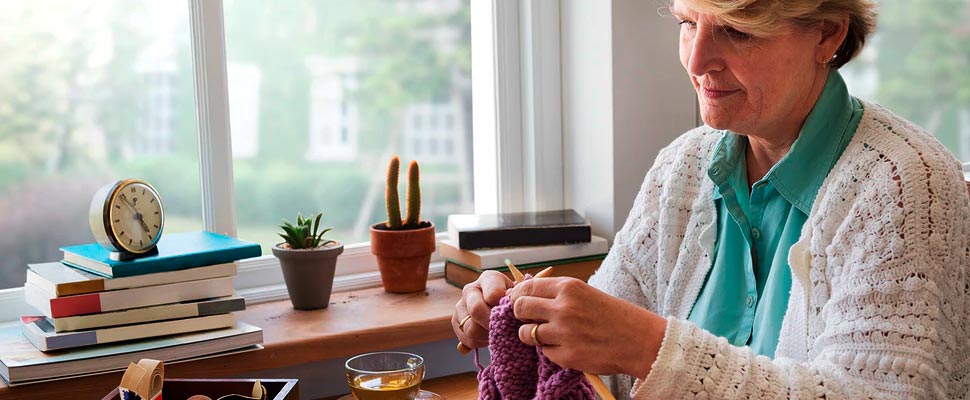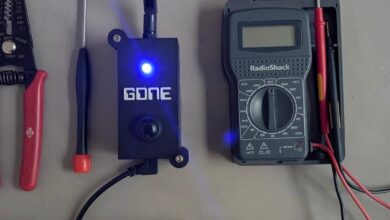You don’t have to leave your home just because you’re getting older
You worked hard for your home – you’ve earned the right to stay there as long as you like. But as you age, safety becomes a consideration

Aging in Place | Carolina Gerard
Listen to this article
You should feel safe in your own home and you need to alleviate the fears of well-meaning loved ones who have concerns about you remaining independent. Below are five, relatively inexpensive, do-it-yourself tools to not only give you peace of mind but improve your quality of life while you stay in the home and with the community you love. Look at the list, determine your needs and discuss them with your partner, caregivers and loved ones – together you can make your home the safe-haven it should be for as long as you choose to live there.
Surveillance Cameras
Surveillance cameras can be purchased at most hardware stores or online, are easily installed and provide remote viewing.
Before purchasing consider these key points:
- Cost: Compare prices to get the best deal, but don’t be penny-wise and pound-foolish – this is an investment you don’t want to replace any time soon.
- Features: Do you want motion detectors and alerts? Assess your needs before purchasing.
- Quality: Purchase a camera from a reputable manufacturer. It should be weatherproof. Look at reviews before you make a commitment.
- Type: You can opt for analog or network versions. Analog (the cheaper option) records footage but cannot stream live to your device. Network cameras have far more to offer.
- Wired or wireless: Wired cameras may require professional installation, wireless cameras (pricier) are simple to install and operate, making them a popular option for those that want simplicity and convenience.
Motion-Activated Lighting
Often, you can replace existing exterior lighting with motion-activated lighting. You can also create a lighted perimeter by using outdoor power sources or battery/solar operated options. This affordable option offers a lot of benefits for the price, including:
- Deterrent: Motion sensor lights act as an excellent deterrent against criminal activity; homes with motion sensors have fewer break-ins than homes with no such lighting.
- Illumination: Security lighting makes it easier for your neighbors to spot when someone approaches your property when they should not be there – allowing them to either walk out on their porch to inspect from a safe distance or call 911.
- Confidence: Arriving home after dark, scrambling for house keys or collecting groceries can be a bit unnerving. Motion lighting will enable you to see properly and enter your home confidently.
- Non-human threats: Sensor lights also deter non-human threats like skunks, coyotes, raccoons and bears.
- Cost efficiency: Unlike traditional outdoor lights, sensor lights only illuminate when needed; they require no manual on/off and save energy and bulbs.
Also read: World-first tool to improve COVID-19 diagnosis, free and online
Doorbell Camera
Few things are as unnerving as an unexpected knock at your door or a stranger ringing your doorbell. Whether it’s in the middle of the day, or in the dark of night, someone has already invaded your space.
Fortunately, there is a relatively new, affordable way to see/talk with someone at your front door without having to open it. A doorbell camera is basically a security camera, motion sensor, and two-way radio all in one. They are readily available online or at major hardware stores and surprisingly affordable. Installation is simple:
- Remove existing doorbell
- Insert new doorbell /camera in original space
- Connect wiring from existing doorbell – A doorbell camera should fit the same terminals
- Secure the doorbell into its proper place using original hardware
- Connect a mobile device or computer with the doorbell. This should work with WiFi or Bluetooth. If you have a cell-phone you can actually see who is at your door.
Medical Alert Systems
Medical Alert Systems have come a long way from the often parodied “I’ve fallen and I can’t get up” commercial. Units now are fashionable, they can be worn as necklaces, bracelets or even watches. Most have fall detectors, GPS for people who still drive, walk, hike or get out and about and the services, and ranges have expanded immensely.
Reasons to Have A Medical Alert System
The fear of falling or suffering any medical emergency is certainly the primary motivator, but not the only reason to consider getting a medical alert system. They assist in other types of emergency help, as well. Systems can monitor for fire, smoke or carbon monoxide. A push of the button will alert the police of a suspected break-in or other suspicious activity. Some mobile devices come with GPS tracking. Other medical alerts can also track activity through motion detectors and beacons. This would allow someone to know something is wrong or if the user has been in one place for an unusual amount of time.
Features to Look For
When choosing your device, there are some features you will want to consider:
- Risk-Free Trial: A risk-free trial will allow you to test one or more devices at home and choose the one you’re most comfortable with.
- Water-Resistant or Waterproof: It’s best to look for a device that is 100 percent waterproof or at the very least, water-resistant so, you can wear it in the shower or bath.
- Long Battery Life: Most systems and devices have a battery life that will last a week or up to a month before requiring a re-charge – do your research to find out the average battery life of the system.
- Signal Range: Medical alert systems either operate through a landline or cellular service. A landline service operates through your traditional telephone line covering a range up to 1,000 feet. A better bet would be cellular coverage which should work anywhere there is cell service.
Also read: The need to implement early travel restrictions against coronavirus
Live Assistance Availability
Look for a monitored service that has medically/emergency trained representatives available 24 hours a day, seven days a week, 365 days a year.
Fall Detection: As mentioned, many monitored and non-monitored systems come with fall detection. Technology allows the device to automatically detect if you fall. It will call for help without you having to do anything.
GPS Tracking: GPS tracking is a great technological advance that is offered on many medical alert systems. It can pinpoint your location and make it easier for someone to find you whether you are inside your home or miles away.
For further information about medical alert systems, including who should consider them and unbiased reviews of the most popular systems visit AginginPlace.org.
Medication Minders
According to the Centers for Disease Control (CDC) up to 50 percent of prescribed medications are taken incorrectly. This can lead to dangerous circumstances when you live alone or with a partner.
Medication management doesn’t have to be hit-or-miss. “Smart” medication management devices remind you when to take your medication, when you need to refill your prescription and even alert caregivers or family members if you neglect to take medication.
Devices like PillPack, Reminder Rosie, Pillo have voice recognition software that can tell you about the medications you’re taking and listen to your commands. They can also be connected to your phone or computer. This is all in the name of making the process of taking medication safer, quicker, and easier.
- Key components to look for include:
- Voice Recognition
- A nice value-add is a unit that can understand and answer your questions.
- Automatic Refills
- Some services allow the user to avoid having to go to pharmacies for refills. Simply upload your rx and they will send your refills to your home.
- Alert Volumes and Reminders
Make sure the volume and type of alert will be heard and acknowledged by the user. Research how often it reminds the user they need to take their medicine should they fail to do so with the first alert.
Drug Interaction Checker
Most pill trackers notify users of dangerous drug interactions, food and alcohol’s damaging effects.
Prescription Refill Reminder
A reminder to refill prescriptions can be just as vital as a reminder to take the medication.
If there’s one place you should always feel safe, it’s in your own home. The above options make it easy and affordable for you to have the peace of mind you desire and deserve.





